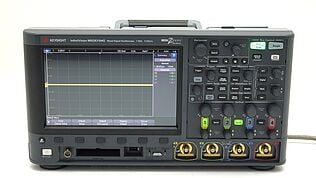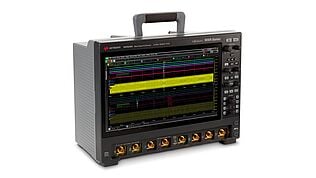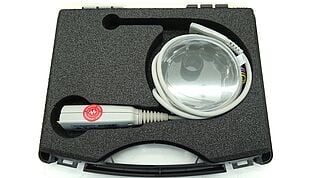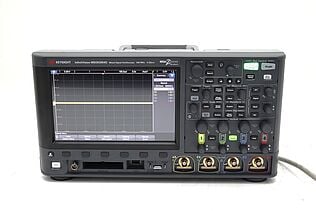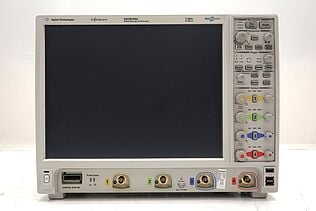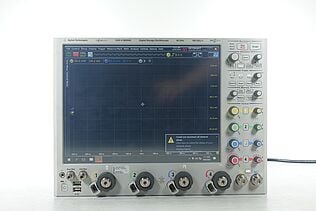- Introduction
- Defining AC Waveforms
- The Sine Wave
- Additional Types of AC Waveforms
- Key Characteristics of AC Waveforms
- Understanding Frequency and Periodicity
- Amplitude and Peak-to-Peak Value
- Phase and Phase Difference
- AC Waveforms in Practice: Oscilloscopes and Testing
- Reading AC Waveforms with an Oscilloscope
- AC Waveform Reference Guide
- AC Waveforms: Application in Power Systems
- Transmission and Distribution
- Motors and Generators
- Conclusion
- Whenever You’re Ready, Here Are 5 Ways We Can Help You
Have you ever considered how the unseen waveforms of alternating current (AC) are fundamental to powering almost everything around us?
Unlike direct current (DC), AC's unique characteristics make it indispensable in powering everything from household appliances to industrial machinery.
This comprehensive guide dives into the AC waveform, a fundamental concept of how modern electrical systems function.
Defining AC Waveforms
An AC waveform is an electrical signal that periodically reverses direction. It's characterized by its:
- Frequency: The number of cycles per second, measured in Hertz (Hz).
- Amplitude: The peak value of the voltage or current.
- Phase: The relative position in time within a cycle.
The Sine Wave
The sine wave stands out as the most prevalent type of AC waveform, known for its smooth and regular oscillation. The mathematical representation of a sine wave is expressed through the following equation:
\( V(t) = V_{max} * sin(2πft + ϕ) \)
In this equation:
- \(V(t) \)represents the voltage at any given time.
- \(V_{max}\) is the peak amplitude of the waveform.
- \(f\) denotes the frequency of the waveform, which is the number of cycles per second.
- \(ϕ\) refers to the phase angle, indicatin0g the wave's displacement in time.
| Key Takeaway |
|---|
| AC waveforms are fundamental to modern electrical systems, with their unique characteristics shaping everything from power transmission to electronic devices. A profound understanding of these waveforms is essential for electrical engineers, especially for in-depth analysis and application. |
Thousands Of Engineers Trust Keysight Oscilloscopes
Additional Types of AC Waveforms
Engineers frequently encounter a variety of AC waveforms beyond the standard sine wave. Each of these waveforms has distinct characteristics and applications.
- Square waves: Predominantly used in digital circuits, square waves represent a binary state of on and off. They are characterized by abrupt transitions between maximum and minimum levels, making them ideal for timing and digital logic operations.
- Triangle waves: These are commonly used in audio applications. Triangle waves have a linear rise and fall, which gives them a unique harmonic profile. This characteristic is beneficial in sound synthesis and audio modulation techniques.
- Sawtooth waves: Sawtooth waves are a staple in television and video display equipment. They have a linear rise and a sharp fall (or vice versa), making them suitable for applications requiring a periodic ramp-up in voltage or current.
Key Characteristics of AC Waveforms
To fully understand and harness the power of AC waveforms in practical applications, it's essential to delve into their key characteristics, including frequency, amplitude, and phase. These properties define the waveform and determine how it behaves in different electrical and electronic systems.
Understanding Frequency and Periodicity
- Frequency (f): This is the number of complete cycles that occur each second. It is measured in Hertz (Hz). In practical terms, a higher frequency indicates more cycles happening every second.
- Period (T): The period represents the time it takes to complete one full waveform cycle. It is inversely proportional to the frequency, calculated using the formula T = 1/f.
Amplitude and Peak-to-Peak Value
- Amplitude: This is the maximum extent of the waveform measured from its central (zero) value. Essentially, it reflects the highest strength or intensity of the waveform at any point.
- Peak-to-Peak Value (Vpp):Vpp measures the total vertical distance between the highest and lowest points of the waveform. It's a crucial measure for understanding the full range of variation in the waveform.
Phase and Phase Difference
- Phase: The phase of an AC waveform indicates its displacement or shift in time relative to a reference point. It's typically measured in degrees (°) and signifies where the waveform begins within a cycle.
- Phase difference: The phase difference is particularly significant when comparing two or more waveforms. It measures the time shift between different waveforms, playing a pivotal role in understanding how they interact.
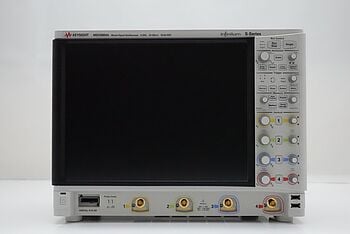
AC Waveforms in Practice: Oscilloscopes and Testing
Understanding AC waveforms is not just about grasping their theoretical aspects; it's also about effectively applying this knowledge in practical scenarios, and this is where tools like oscilloscopes become invaluable. They help visualize AC waveforms and play a crucial role in analyzing and troubleshooting electrical and electronic systems.
Reading AC Waveforms with an Oscilloscope
Using an oscilloscope to read AC waveforms involves a few critical steps:
- Connect the probe to the circuit.
- Adjust the time base and amplitude settings. Proper adjustment of these settings is key to accurately displaying the waveform.
- Observe the waveform, focusing on its frequency, amplitude, and shape. This observation provides insights into the behavior of the electrical signal.
It’s also important to understand the oscilloscope's various features and how they can be used to analyze AC waveforms.
- Triggering controls: Adjusting the trigger level ensures a stable display of the waveform, which is particularly important for capturing and analyzing transient or irregular signals.
- Bandwidth and resolution: The oscilloscope's bandwidth affects its ability to accurately display higher frequency components, while resolution influences the detail visible in the waveform.
- Measurement tools: Most modern oscilloscopes come equipped with digital measurement tools. These can automatically calculate important parameters of the waveform, such as peak values, frequency, and RMS values, enhancing the efficiency and accuracy of analysis.
- Waveform storage and comparison: The ability to store and recall waveforms is essential for comparing changes over time or under different conditions, aiding in diagnosis and design optimization.
AC Waveform Reference Guide
| Type of Waveform | Characteristics | Common Applications | Key Points |
|---|---|---|---|
| Sine Wave | Smooth, periodic oscillation | General AC power, audio equipment | Ideal for uniform, periodic power transmission and audio signal representation |
| Square Wave | Abrupt transitions between high and low states | Digital circuits, timing systems | Useful for binary systems, timing and digital logic operations |
| Triangle Wave | Linear rise and fall | Audio synthesizers, signal modulation | Employed in audio applications for its harmonic characteristics |
| Sawtooth Wave | Linear rise with sharp fall (or vice versa) | Television, video display equipment | Used for scanning in TV and video, and in some types of oscillators |
| Complex Waveforms | Composed of multiple frequencies and wave shapes | Signal processing, telecommunications | Analyzed using Fourier analysis to understand frequency components |
AC Waveforms: Application in Power Systems
Transmission and Distribution
AC waveforms are pivotal in the transmission and distribution of electrical power due to their transformability. They can be easily stepped up or down in voltage using transformers, allowing for efficient power transmission over vast distances. High-voltage transmission minimizes energy loss due to resistance in the lines, while lower voltages in local distribution networks ensure safety and practicality for end-users. This flexibility is a key reason why AC systems dominate the world's power grids.
Motors and Generators
AC waveforms are integral to the functioning of electric motors and generators. These devices operate on the principles of electromagnetic induction, with AC waveforms providing the necessary alternating magnetic fields.
In motors, these waveforms induce a rotating magnetic field that drives motion, essential in everything from household appliances to industrial machinery.
In generators, mechanical motion is converted into electrical energy, with AC waveforms being generated as the coils rotate within a magnetic field.
This interplay of AC waveforms in motors and generators underpins much of the modern industrial and technological landscape, showcasing the versatility and indispensability of AC power in our daily lives.
Get Your Used Oscilloscope On Sale With Faster-Than-New Delivery
Select up to 3 instruments to compare
Enable Notifications
In order to use this feature, you need to enable notifications.
Manage notification preferences
Conclusion
AC waveforms are vital to modern electrical and electronic systems. From powering homes and industries to driving sophisticated technological applications, their significance cannot be overstated. Understanding AC waveforms is crucial for anyone involved in the electrical engineering field.
Are you looking to explore AC waveforms further? Visit the Keysight Used Equipment Store for an array of premium used oscilloscopes, spectrum analyzers, waveform generators, and multimeters. These tools are essential for anyone keen on delving deeper into AC waveforms. Discover high-quality equipment at competitive prices to enhance your analysis and understanding of AC waveforms.

Whenever You’re Ready, Here Are 5 Ways We Can Help You
- Browse our Premium Used Oscilloscopes.
- Call tech support US: +1 800 829-4444
Press #, then 2. Hours: 7 am – 5 pm MT, Mon– Fri - Talk to our sales support team by clicking the icon (bottom right corner) on every offer page
- Create an account to get price alerts and access to exclusive waitlists.
- Talk to your account manager about your specific needs.



